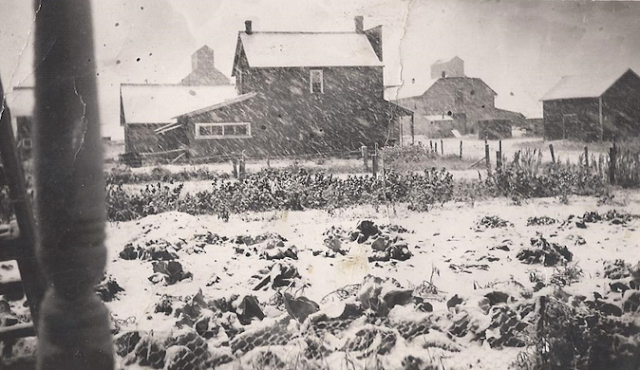 |
| Grand Coulee, October 1913 Photo courtesy of http://www.anitamaedraper.com/author-memories/1913-grand-coulee-sask |
 |
| Section map showing George's farm in green, Grand Coulee just north, and part of Regina to the east. Click the map to read it. |
 |
| The location of the farm today, photographed from its SE corner. George's house and other buildings no longer stand. |
Grand Coulee is a very small town about 100 miles west of Summerberry and 10 miles west of Regina. The 640 acres George purchased there were on the NW corner of where the Trans-Canada Highway now meets Range Road just south of the town. The family lived there until about 1919.
 |
| The Smith house at Grand Coulee |
These were eventful years, in which George spent some time in England and in California, four more of his children got married, several grandchildren were born, his eldest daughter passed away and a tornado devastated Regina. I'll say more about some of these things in the next few posts.
Of course the most far-reaching event of the time was the first world war. All three of George and Louisa's sons, and their sons-in-law, were of an age to go to war, but none of them volunteered, and when conscription came to Canada in 1917, farmers, their sons and their hired labourers were exempt, due to the need for an adequate agricultural workforce to be maintained.
Before the war, Saskatchewan farmers were in an economic slump. Grain prices had dropped, and three years of drought and crop failures had taken their toll. But soon after the war began, the Allies' demand for Canadian wheat was high, and production expanded dramatically. The 1915 harvest, for example, was the largest in Saskatchewan's history. And the price of wheat rose too. By 1917, the price was fixed at $2.21 a bushel, three times the pre-war price, and one acre of land could produce anywhere from 40 to 60 bushels. If George had just half of his land at Grand Coulee producing wheat at 50 bushels an acre, he would have made more than $35,000 a year, not to mention the land he still owned at Summerberry. But the cost of production rose too - farm machinery prices soared, and wages for farm labourers more than doubled. (1)
While the war didn't take the lives of anyone in George's family, there were many friends who weren't so lucky. One such family, who also lived at Grand Coulee at the time, less than 2 miles from the Smiths, were the Wanamakers. A strong friendship grew between these two families, and eventually a relationship or two, too. Both families were faithful Methodist churchgoers, and active participants in the life of the church - they've been described as the mainstays of the church, and of the church choir - and no doubt that's where they met. When the Wanamakers' son Frederick was killed in France in 1917, the loss was a blow to both families. (2)
I'll discuss the Wanamakers in more detail in later posts, when I finally stop rabbiting on about George and Louisa!
One of my favourite photos from the Grand Coulee years is this one of George and Louisa's daughter Prue, taken around 1910. Prue had many talents, including needlework, cooking and baking, singing, playing the piano, bringing in the harvest and shooting hawks. (2)
Prue Smith at about age 17,
with a hawk and a gun. |
1) 'The Impact of the First World War on Saskatchewan's Farm Families', Joan Champ, 2002
2) As told by my grandmother Myrtle Wanamaker to my cousin Donna




Great job on the research, Linda! I have images of a Ray or Roy Smith and a bunch of fish, but not a hawk! Your Prue must've been a crack shot.
ReplyDelete